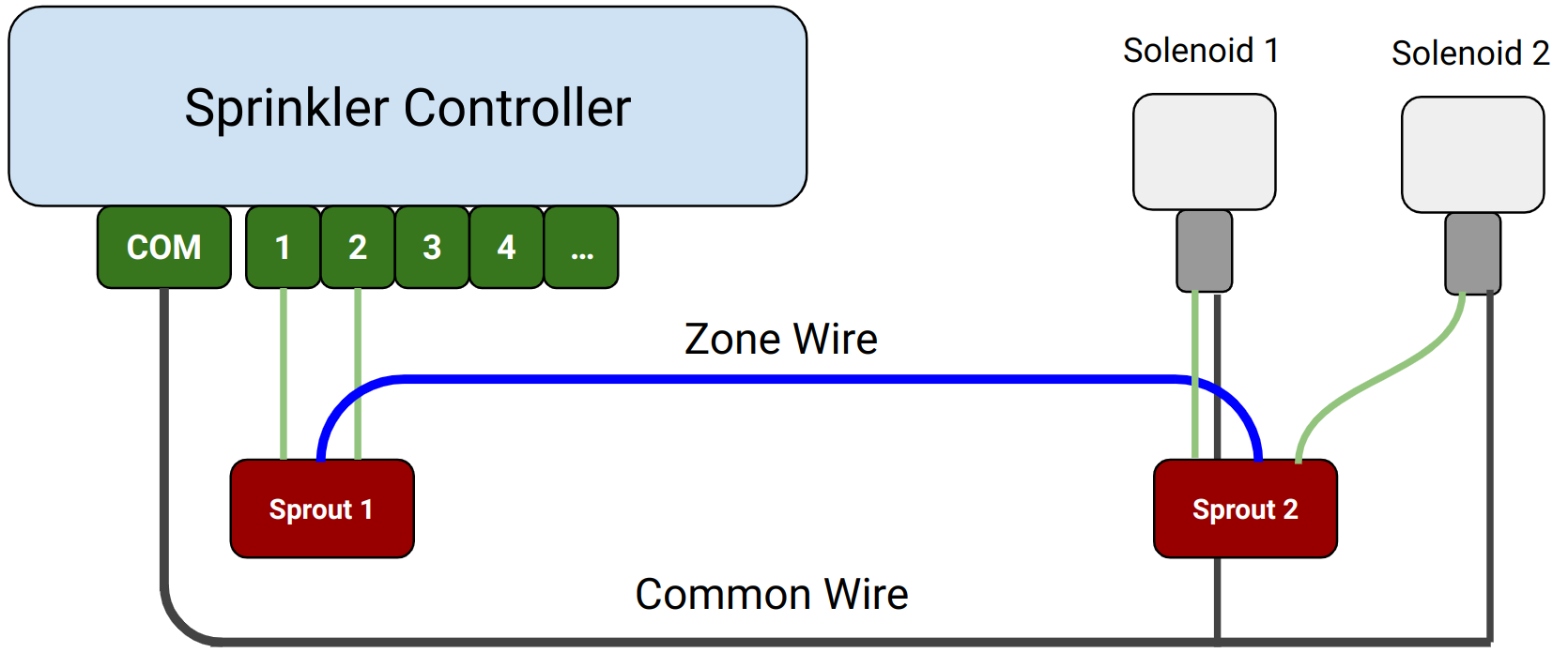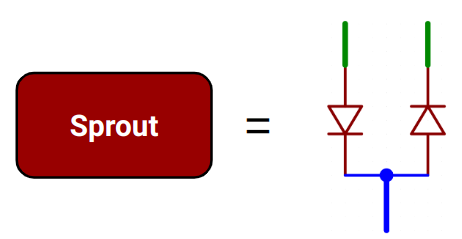Recently through a customer I learned about a product called WireSprout, and it only works with the AC-powered OpenSprinkler but not the DC-powered version. Out of curiosity, I looked into why this is happening. So what is WireSprout? Simply speaking, it allows individually controlling 2 zones using a single zone wire. This is useful in situations where some of your zone wires are broken and it’s too much hassle to repair the broken wires. Let’s say you have 2 zones, but only 1 good zone wire. Using WireSprout, you to control both zones using the single good zone wire. This works on any sprinkler controller (well, as you will see later, as long as it’s an AC sprinkler controller). A single WireSprout pack contains a pair of two ‘sprouts’. Each sprout is a tiny little circuit wrapped in heat shrink tubing, and has 3 wires: 1 blue and 2 green wires. Below is the diagram that shows how to connect it to a sprinkler controller:

To be fair it’s not adding more zones — to control 2 zones you still need to take 2 zone ports on the sprinkler controller. Also it requires the Common (COM) wire to be a good (i.e. non-broken) wire. But what it helps with is to reduce the number of zone wires. Note that it can only go with a pair of 2 zones. For example, if you want to control 4 zones, you need another good zone wire and another pack of sprouts. It unfortunately cannot allow you to control 4 zones with a single good zone wire.
Each sprout is very small, so likely it only contains a few electronic components. Also, it’s very general — it can work with any AC sprinkler controller, so the circuit doesn’t rely on the knowledge of any specific controller. It also works only for 2 zones at a time. Finally according to the customer, it doesn’t work with DC-powered OpenSprinkler, only works with AC-powered version. So it must rely on the property of AC to work. I googled similar products, and after a bit of research, it became clear to me that the circuit is indeed extremely simple. Each sprout is essentially two diodes in series, where the two ends are the green wires, and the center (between the two diodes) is the blue wire. Below is what I believe each sprout contains internally:

So how does it work all together? Here is the diagram:

Because the output voltage is AC, it has positive and negative cycles. As you can see, on the positive cycle of the COM wire, if Zone 2 port is on, the two diodes circled green will turn on. So the current flows from COM to Solenoid 1 through the Common wire, then through the zone wire to Zone 2 port. The other two diodes are reverse biased therefore solenoid 2 cannot turn on even if Zone 1 port is on. Conversely, on the negative cycle of the COM wire, the situations with all diodes are flipped, so only Solenoid 2 can turn on (assuming Zone port 1 is on). In this particular arrangement, Zone port 1 controls Solenoid 2, and Zone port 2 controls Solenoid 1. If you want them to correspond to each other (i.e. 1 -> 1 and 2 -> 2), just horizontally flip one of the sprouts.
In short, the WireSprout works by leveraging the fact that AC waves have positive and negative cycles. By using diodes, it can cleverly block half of the AC waves, therefore Solenoid 1 can only turn on during the positive cycles, and Solenoid 2 can only turn on during the negative cycles, or vice versa. Thus these two zones can be individually controlled.
Now it’s obvious why the DC-powered OpenSprinkler can’t work with WireSprout: DC-powered OpenSprinkler outputs DC-only voltage, there are no positive or negative cycles — there is only positive voltage. Therefore WireSprout can’t leverage the negative cycles to disable one of the solenoids therefore it cannot achieve individual control of 2 solenoids using a single zone wire.
There is possibly a downside of this method: each solenoid only get half of the AC waves as opposed to the full wave normally. Would this cause any reliability issues? I am not sure, but it seems there hasn’t been any reported issue so far.
Finally, we can also explain why WireSprout always works in pairs of 2 and not more than that: if you want to control, say 4 solenoids with a single zone wire, that would require counting the parity of the AC waves, which would be much more complex and may require an active circuit.
